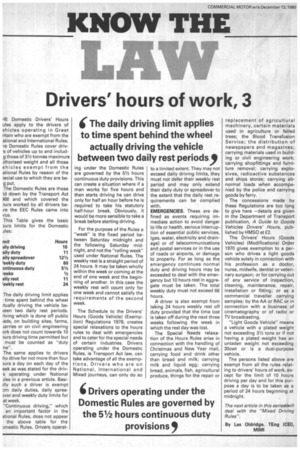Drivers' hours of work, 3
Page 68

If you've noticed an error in this article please click here to report it so we can fix it.
The daily driving limit applies to time spent behind the wheel actually driving the vehicle between two daily rest periods
-IE Domestic Drivers' Hours ules apply to the drivers of ehicles operating in Great ritain who are exempt from the ational and International Rules, le Domestic Rules cover driv-s of vehicles up to and includg those of 31/2 tonnes maximum Jthorised weight and all those chides exempt from the ational Rules by reason of the aecial use to which they are beg put.
The Domestic Rules are those id down by the Transport Act )68 and which covered the u rs worked by all drivers bere the EEC Rules came into ,rce.
This Table gives the basic )urs limits for the Domestic Jles:
The daily driving limit applies time spent behind the wheel :Wally driving the vehicle bedeen two daily rest periods. riving which is done off public pads, on building sites, farms, Jarries or on civil engineering ark does not count towards 10 )urs driving time permitted but must be counted as "duty -ne".
The same applies to drivers ho drive for not more than four )urs a day on each, day of the eek as was stated for the drivs operating under National Jles in a previous article. Basiilly such a driver is exempt m daily duties, daily spreepier and weekly duty limits for at week.
"Continuous driving," which an important factor in the ational Rules, does not appear
the above table for the )mestic Rules. Drivers operat
ing under the Domestic Rules are governed by the 51/2 hours continuous duty provisions. This can create a situation where if a man works for five hours and then starts driving he can drive only for half an hour before he is required to take his statutory half-hour break. Obviously, it would be more sensible to take a break before starting driving.
For the purpose of the Rules a "week" is the fixed period between Saturday midnight and the following Saturday midnight, and not the "rolling week" used under National Rules. The weekly rest is a straight period of 24 hours. It may be taken wholly within the week or coming at the end of one week and the beginning of another. In this case the weekly rest will count only for one week and cannot satisfy the requirements of the second week.
The Schedule to the Drivers' Hours (Goods Vehicle) (Exemption) Regulations 1978, creates special relaxations to the hours rules to deal with emergencies and to cater for the special needs of certain industries. Drivers operating under the Domestic Rules, ie Transport Act law, can take advantage of all the exemption s. Drivers who are on National, International and Mixed journeys, can only do so to a limited extent. They may not exceed daily driving limits, they must not defer their weekly rest period and may only extend their daily duty or spreadover to the extent that the daily rest requirements can be complied with.
EMERGENCIES. These are defined as events requiring immediate action to avoid danger to life or health, serious interruption of essential public services, (gas, water, electricity and drainage) or of telecommunications and postal services or in the use of roads or airports, or damage to property. For as long as the emergency continues normal duty and driving hours may be exceeded to deal with the emergency but 10 hours rest in aggregate must be taken. The total weekly duty must not exceed 66 hours.
A driver is also exempt from taking 24 hours weekly rest off duty provided that the time lost is taken off during the next three weeks following the week in which the rest day was lost.
The Special Needs relaxation of the Hours Rules arise in connection with the handling of Christmas and New Year mail, carrying food and drink other than bread and milk; carrying milk and liquid egg; carrying bread, animals, fish, agricultural produce, things for the repair or replacement of agricultural machinery, certain materials used in agriculture or felled trees; the Blood Transfusion Service; the distribution of newspapers and magazines; carrying materials used in building or civil engineering work; carrying shopfittings and furniture removal; carrying explosives, radioactive substances and ships stores; carrying abnormal loads when accompanied by the police and carrying goods by ferry.
The concessions made by these Regulations are too long to give here —details are given in the Department of Transport publication, A Guide to Goods Vehicles Drivers' Hours, published by HMSO at £2.
The Drivers' Hours (Goods Vehicles) (Modifications) Order 1970 gives exemption to a person who drives a light goods vehicle solely in connection with his profession as a doctor, nurse, midwife, dentist or veterinary surgeon; or for carrying out of any service of inspection, cleaning, maintenance, repair, installation or fitting; or as a commercial traveller carrying samples; by the AA or RAC or in connection with a business, of cinematography or of radio or TV broadcasting.
"Light Goods Vehicle" means a vehicle with a plated weight not exceeding 31/2 tons or if not having a plated weight has an unladen weight not exceeding 30owt or is a dual-purpose vehicle.
The persons listed above are exempt from all the rules relating to drivers' hours of work, except for the limit of 10 hours driving per day and for this purpose a day is to be taken as a period of 24 hours beginning at midnight.
The next article in this seriestWill deal with the "Mixed Driving Rules".
By Les Oldridge, TEng (CEO, MIMI
















































































































